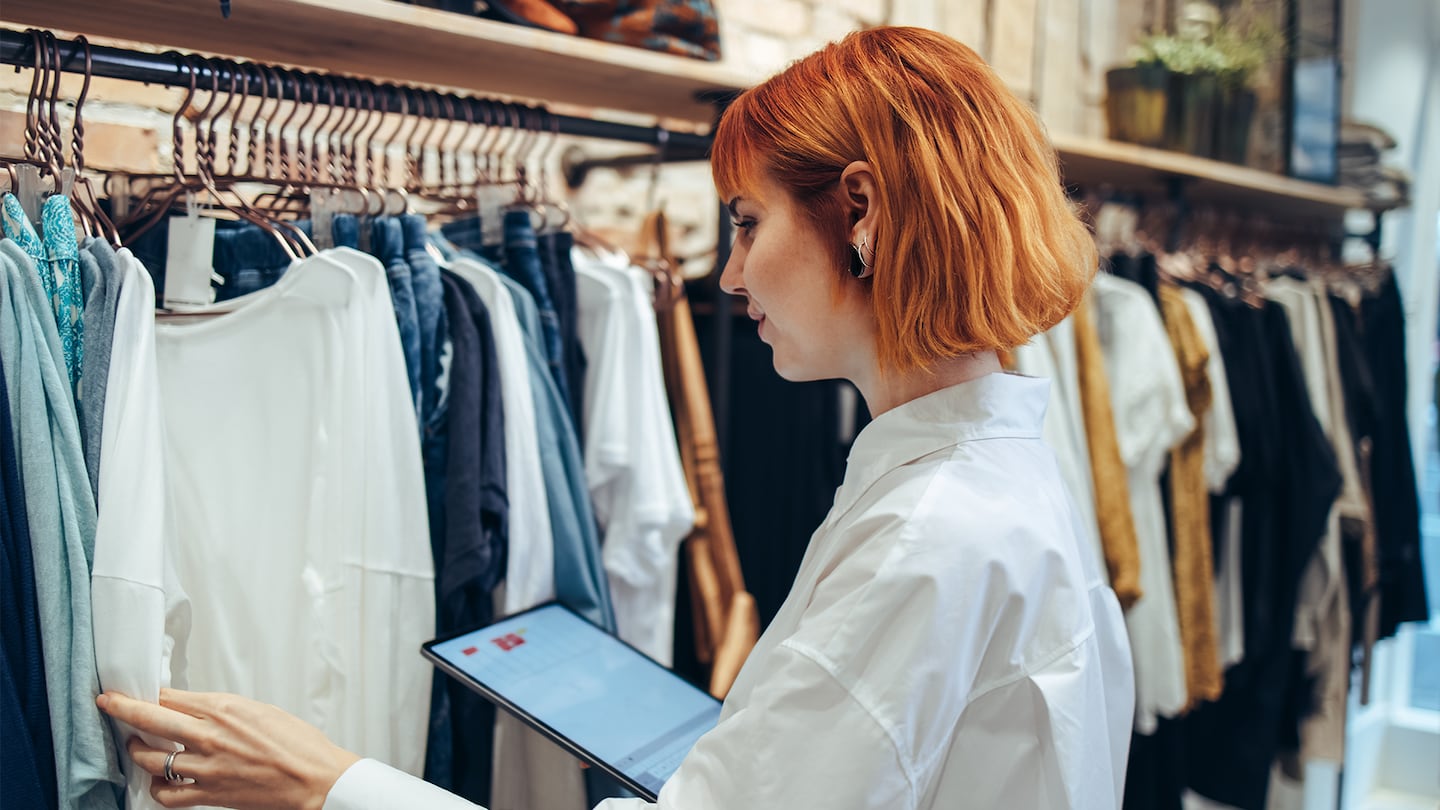
The Business of Fashion
Agenda-setting intelligence, analysis and advice for the global fashion community.

Agenda-setting intelligence, analysis and advice for the global fashion community.

According to a McKinsey & Co. survey, more than one-third of Americans have made omnichannel features such as buying online for in-store pickup part of their regular shopping routine since the pandemic, and nearly two-thirds of those individuals plan to continue.
Founded in 2013, retail solutions platform Teamwork Commerce uses mPOS (mobile point-of-sale) to unlock efficiencies across the breadth of the retail ecosystem as an end-to-end technology provider, from order management and inventory control through to analytics and reporting — all via iOS devices. It operates as a cloud-based, omnichannel system, focused on mobile solutions for retail store networks.
Today, it supports more than 5000 stores in 21 countries with a suite of service-oriented solutions. Teamwork’s integrated CRM tool, for instance, allows retailers to create a single source of information around an individual customer, tracking intent and behaviour as well as enabling consistent cross-channel visibility.

Now, BoF sits down with Teamwork Commerce CEO Michael Mauerer to discuss the operational innovations required to optimise omnichannel retail, how unified customer views can help gauge the efficiency of retail networks and ROI, as well as the long-term growth opportunities found in personalising retail experiences.
Which tech-driven retail solutions are finding success in today’s retail market?
Shoppers today are divided into two strong consumer sentiments — they either want white glove service, or want to be left alone to self-serve, with an emphasis on conveniently getting what they need. The middle ground — where retail service has traditionally [operated] — no longer serves those two extremes.
To cater to the service-oriented shopper, whether they’re shopping online, in-store or through a connected social campaign, the shopper wants to be recognised. Building customer data [profiles] across all channels allows the customer to be conveniently serviced in every way — from buy-online, pickup-in-store, to pulling from the e-commerce inventory in-store.
For the customer who desires low touch experiences, self-checkout solutions are providing retailers with significant success. Self-checkout reduces lines at the store and the [friction] of paying at the till. Having paid for it using RFID technology, the self-checkout process is made extremely fast. A basket of goods can be checked out without scanning items individually – just place the items in, group receipt and pay via your phone.
At Teamwork, our RFID technology is implemented on this level to support this function, while also giving good inventory control intelligence. What we’ve seen from this is that in situations, we can [streamline] operations and costs without any increase in inventory loss. That positive impact on the bottom line provides more resources to better service the high touch clients. For retailers, this means a more balanced and effective use of your personnel resources.
What insights can Teamwork Commerce share around evolving shopper behaviour?
Creating brand loyalty is more important than ever. Consumers are faced with an endless amount of options. And, while it’s never been easier to start a clothing brand, it’s never been harder to capture new customers. As a result, retention — over acquisition — is [emerging] as an industry priority. For retailers, this requires an expansion of focus, moving away from being wholly focused on product and honing in on the customer themselves. This means not only [considering] customer need, but also increasing their responsiveness to ensure exceptional service.
Technology should be used to support and augment the personal hands-on experience. The world of retail is not going to be exclusively the website.
Another key area of focus is responding to the opportunity [presented] in the diminishing barriers when it comes to selling across borders. There is a real business need for unified, omnichannel solutions to operate effectively in multiple countries, languages and currencies.
What are the new applications of a single customer view that drive growth?
A single customer view offers the capability to recognise and engage with the customer whenever and wherever they purchase — be that online, in-store or even through social media. Applying that view back into customer service, [particularly] in the form of customer recognition, can help to cement brand loyalty. Customers are inundated with impersonal marketing messages, so when a brand gives them something target and personal, that has impact.
Having a centralised customer data platform that efficiently serves all the endpoints of the business is essential to [drive growth]. It’s effectively the primary infrastructure that has to be in place to facilitate any other applications. At Teamwork, we’ve actually been developing this concept for several years, and it [requires] significant technical architecture to [achieve]. A simple example of its potential is the system calculating a recommendation for the customer using artificial intelligence — specifically an algorithm — that eliminates items that were already returned or tried on and not bought by the customer. It’s a simple concept to understand on a human level — [customers] don’t wish to be pushed repeat product. They want retailers to show recognition.
Another application is really simplifying the returns process. Crediting returns in-store for product bought online, transferring inventory to stores; those many workflows can be engineered and simplified via a single customer data platform.
How is the role of both store associates and store managers evolving in a post-pandemic environment?
Despite the current trend towards more high-tech solutions, what we’re really seeing is that tried and true basics of customer service go a long way towards customer satisfaction, retention, and repeat purchases. Technology cannot replace human contact, or personal touch. Rather, technology should be used to support and augment the personal hands-on experience. The world of retail is not going to be exclusively the website.
There is a real business need for unified, omnichannel solutions to operate effectively in multiple countries, languages and currencies.
Store associates now have to provide service not only to people that are in the store, but to shoppers remotely via video call. Now, direct, one-on-one video is eliminating distance barriers. Teamwork has just partnered with a company called High Touch to [facilitate] this capability, meaning customers no longer have to come into stores to even really experience the store. They can do it through their phone from anywhere.
Associates who take on the role of a stylist by suggesting products to customers can do this through video effectively. In fact, it’s a far richer experience than just clicking through website pages with no interactive communication. It can also be used to prevent customer loss. If a customer is upset, showing true commitment to the customer through a video session indicates a passion for service, while letting the associate return the product in the background and potentially even convert it into another sale.
What innovations to digital clienteling are emerging as growth levers?
Digital communications — whether text, voice or video — are the new major players within clienteling. That sense of live communication is moving the needle, as opposed to blanket email messaging, which are often confused with marketed messages. Clienteling is really about servicing a client, not marketing to a client, even though people and great service is the best marketing there is.
Technologies like machine learning will also empower the associate to ascertain what messages will be the most meaningful to each customer, as it can analyse their history and behaviour. While the [associate] could read up on their purchase history, it’s far more convenient to have machine learning [capabilities] achieve in a second what a store associate would do in 15 minutes. The meaningful messages themselves are very nuanced — again, because it has to do with past buying patterns. Even remembering what the customer says they dislike is equally important.
This is a sponsored feature paid for by Teamwork Commerce as part of a BoF partnership.
The British musician will collaborate with the Swiss brand on a collection of training apparel, and will serve as the face of their first collection to be released in August.
Designer brands including Gucci and Anya Hindmarch have been left millions of pounds out of pocket and some customers will not get refunds after the online fashion site collapsed owing more than £210m last month.
Antitrust enforcers said Tapestry’s acquisition of Capri would raise prices on handbags and accessories in the affordable luxury sector, harming consumers.
As a push to maximise sales of its popular Samba model starts to weigh on its desirability, the German sportswear giant is betting on other retro sneaker styles to tap surging demand for the 1980s ‘Terrace’ look. But fashion cycles come and go, cautions Andrea Felsted.